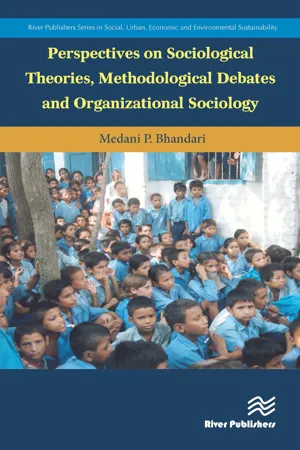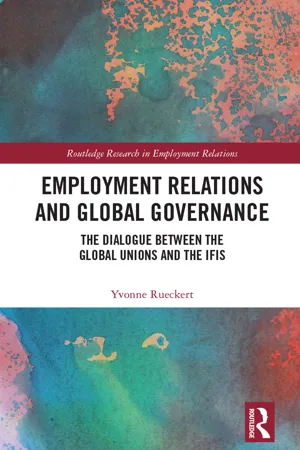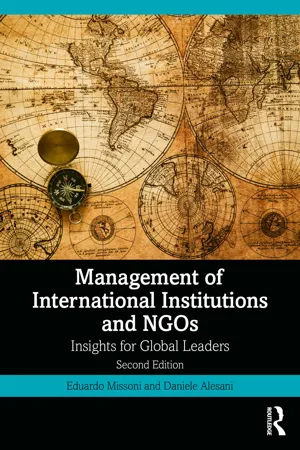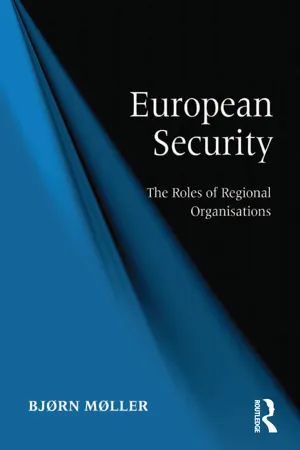Social Sciences
Global Organisations
Global organizations are entities that operate across national borders, with a focus on addressing global issues such as poverty, human rights, and environmental sustainability. These organizations often include international governmental organizations (IGOs) like the United Nations, as well as non-governmental organizations (NGOs) and multinational corporations that work on a global scale to achieve their objectives.
Written by Perlego with AI-assistance
Related key terms
5 Key excerpts on "Global Organisations"
- eBook - ePub
- Medani P. Bhandari(Author)
- 2023(Publication Date)
- River Publishers(Publisher)
In the social sciences, governance is also sometimes explained in Foucaultian terms (Baldwin 2003; Agrawal 2005), where government means less of the political or administrative structures of the modern state but the people’s internalization of the rules that leads to types of self-governance, which is governance without active external enforcement (Foucault 1991). Foucault’s work is notable; it (philosophically) illustrates extensive social and political structures, including the state, bureaucracy, and professions which will be helpful to explore how knowledge and power utilize by the hybrid international organization (such as IUCN) at the state and transnational levels (Bhandari 2018, 2019, 2020). Conclusion Social science epistemologies have historically been developed to tackle social problems, and formal and informal organizations were formed to address social issues as they appeared. When socioeconomic and political problems cross borders, international organizations form to tackle those issues on an international scale. The term “international organizations” was first used by a Professor of Law, James Lorimer, in 1867 and became a major field of study in political science by 1900. In the contemporary world, the role of international organizations is universal. International organizations represent a form of institution that refers to a formal system of rules and objectives, a rationalized administrative instrument (Selznick 1957). There are varieties of international organizations according to their objectives and their functions. There are three categories of organizations: intergovernmental organizations, international non-governmental organizations (INGOs), and multinational enterprises. To consider any organization as international, there should be a formal instrument of agreement between the governments of nationstates including three or more nation-states as parties to the agreement and possessing a permanent secretariat performing ongoing tasks - eBook - ePub
Employment Relations and Global Governance
The Dialogue between the Global Unions and the IFIs
- Yvonne Rueckert(Author)
- 2023(Publication Date)
- Routledge(Publisher)
Labour issues are outside the primary mandate and mission of the IFIs. For that reason, the IFIs can profit from amplifying their own expertise in this field through the dialogue with the trade unions and the ILO. The amplification of expertise and the consideration of arguments brought forward within the dialogue depend on the willingness of the organisations to cooperate and to learn. Due to the high degree of voluntariness involved in global governance, corporate actors have an even higher self-responsibility as regards the development of a global social dimension. The exercise of this responsibility, which includes exchange and cooperation with other international corporate actors, is determined by organisational characteristics, which will be considered in the following sections.Organisation theories
Organisation theories can help to explain and analyse organisational characteristics and contribute to the analytical perspective of global governance. The analysis of these characteristics is important because of two reasons. First, organisational particularities can illuminate possible obstacles and common grounds as regards joint interaction. Second, they can help to specify and further develop the analytical dimension of the global governance concept by explaining the mode of operation of new forms of regulation and cooperation, such as manifested in the examined policy dialogue.Figure2.1Organisational Theories and Global GovernanceSource: Own illustrationThe link between the global governance concept and organisation theories relating to the dialogue aims to provide a better understanding of how the participating corporate actors react to and deal with global problems, how they respond to stimuli anchored in their environment, and why they respond in the way they do.International relations theorists are not the only ones who are important for understanding international cooperation and global governance. Organisation theorists, especially from sociology, provide insights relevant to studying international organisations as organisations. - eBook - ePub
Management of International Institutions and NGOs
Insights for Global Leaders
- Eduardo Missoni, Daniele Alesani(Authors)
- 2023(Publication Date)
- Routledge(Publisher)
WHO clearly includes as “private sector” business associations representing commercial enterprises. It identifies international business associations asPrivate sector entities that do not intend to make a profit for themselves but represent the interests of their members, which are commercial enterprises and/or national or other business associations.(WHO 2016 )In other words, WHO groups organizations as NGOs, private sector (i.e., businesses), and philanthropic foundations (see below) according to the interests they represent rather than according to their legal nature.Until recently, the civil society concept by and large referred to the local or the national space; over the last two decades we witnessed a growing discourse regarding “global civil society” formally or informally linking together, across national boundaries, a great variety of groupings such as social movements and networks (Lewis 2007 : 66).Without attempting to give a precise definition of the terms, for our purpose we may say that social movements and their global equivalents are scarcely structured, spontaneous collectivities, that bring together, individuals, groups, and organizations with a common cause, sharing the awareness of a common destiny and building concerted action, but with loose associations among their participants and without having one overall formal organization. With the impressive breakthroughs in communication technologies, as well as global interconnectedness, social movements have progressively organized as networks, polycentric, and flexible, increasingly generating and instantly sharing information, to create synergic action.A number of authors have defined networks as new organizational models which are multistakeholder and cross-sectoral (i.e., linking business, state, and the third sector). Among them, Waddell (2011 ) refers to global action networks or GANs as a specific type of network combining to a significant degree seven characteristics and with different “level[s] of organizing”. Many GANs belong to the kind of hybrids that we will describe later (see Chapter 3 - eBook - ePub
European Security
The Roles of Regional Organisations
- Bjørn Møller(Author)
- 2016(Publication Date)
- Routledge(Publisher)
Today the topic is rather international organisation (in the singular) and very little is published about organisations (in the plural), which are at most included as case studies for more general and/or abstract theories about multilateralism, regimes and the like (Rochester 1986; Verbeek 1998). On the other hand, even though the several journals which are more or less exclusively devoted to the European Union do provide space for analysis of its organisational features, most contributors treat the EU as something sui generis and they are generally very reluctant to generalise from their findings. The various journals devoted to organisations, public management and administration, in turn, focus almost exclusively on the national level and almost completely disregard international organisations. Hence, the organisational features of international organisations constitutes a rather under-researched field which is also reflected in the following pages, which are partly based on what is known about national organisations applied to international organisations, even though the validity of this can by no means be taken for granted (Ness and Brechin 1988; Fisdick 2000). Organisational Parameters As organizations, international ones differ from each other along several parameters such as membership, structure and decision-making mode and legal status, all of which have a strong impact on the organisation’s strength (Rittberger and Zangl 2006). As far as membership is concerned, this is both a matter of the nature of the members and the inclusiveness of membership. Most international organisations have exclusively states as members, but some also allow for some form of representation of non-state actors such as state-like polities (e.g. Taiwan or the Palestinian Authority), other international organisations, NGOs or parts of the business community (vide infra) - eBook - ePub
International Social Work
Issues, Strategies, and Programs
- David R. Cox, Manohar Pawar(Authors)
- 2012(Publication Date)
- SAGE Publications, Inc(Publisher)
2 research and development over the past five years. In 2010, it spent $13 billion on goods and services from companies in countries with lower incomes, and $121 million on voluntary social investments (in lower income countries alone $61 million). Its governance is through the executive committee and board of directors, and one of the directors is chair of the corporate and social responsibility committee. Its social performance framework includes requirements for the way the company engages with neighbors of major facilities. According to this framework, it has trained 250 social performance specialists. They also employ sustainable development integrators who facilitate input from and benefit to local communities, influence project planning and decisions, and help to obtain regulatory approvals (Shell, 2010, p. 3). It has advertised for positions such as manufacturing communications and social performance advisors, social impact assessors, and community liaison officers. We regard social work knowledge and skills as useful for these jobs, but this background alone is not enough, as relevant industry exposure and experience are also needed. The above two corporations and similar multinational companies probably need to be informed of and convinced about the roles that social workers can play in the community projects, as their position advertisements do not explicitly include social work as a required or possible qualification. As many multinational companies have recently introduced social performance positions and are relatively new to this area, proactive initiatives are needed by social workers or the profession.Global Civil Society
The concept of global civil society has been discussed in Chapter 3 . It is an umbrella concept with so much included within it that the concept remains rather unclear. Diverse organizations such as international and national nongovernmental organizations, social movements, trade unions, voluntary associations, foundations and philanthropic trusts, independent media social networks, think-tanks and research institutes, women's and men's groups, advocacy groups, faith-based organizations, and social movements are commonly included in global civil society. Here it is not practical to cover all these types of organizations, so, again as examples, we shall discuss one social movement, the World Social Forum, and one foundation, the Bill and Melinda Gates Foundation. Readers should, however, appreciate the tremendous range of organizations that make up global civil society (see Chapter 3
Index pages curate the most relevant extracts from our library of academic textbooks. They’ve been created using an in-house natural language model (NLM), each adding context and meaning to key research topics.




